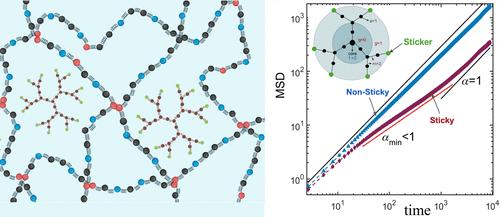Subdiffusion of Sticky Dendrimers in an Associative Polymer Network
IF 5.2
1区 化学
Q1 POLYMER SCIENCE
引用次数: 0
Abstract
We investigate the static and dynamic properties of dendrimers diffusing through a network of linear associative polymers using coarse-grained Brownian dynamics simulations. Both dendrimers and network chains are modeled as bead–spring chain polymers, with hydrodynamic interactions incorporated for the accurate prediction of dynamic properties. Linear chains form a network via the associating groups distributed along their backbones, and the dendrimers interact attractively or repulsively with the network, enabling a direct comparison of sticky and nonsticky behaviors of dendrimers. Structural analysis reveals that while nonsticky dendrimers shrink with increasing network concentration, similar to linear polymer behavior, sticky dendrimers exhibit stretching at low concentrations due to binding interactions. Dendrimer dynamics are largely insensitive to network architecture but are strongly influenced by the strength of dendrimer–network interactions. Increasing attraction to the network leads to subdiffusive motion and non-Gaussian displacement statistics, even when dendrimers are smaller than the average mesh size. The long-time diffusivity aligns with theoretical predictions for nanoparticle transport in polymer networks. Additionally, dendrimers deform the network locally, altering the mesh size distribution depending on their stickiness. These findings offer insight into the interplay among macromolecular architecture, binding interactions, and transport in polymeric environments.

粘性树状大分子在缔合聚合物网络中的亚扩散
我们使用粗粒度的布朗动力学模拟研究了树状大分子通过线性结合聚合物网络扩散的静态和动态特性。树状大分子和网络链都被建模为串珠弹簧链聚合物,并结合了流体动力学相互作用,以准确预测其动力学性质。线性链通过沿主干分布的缔合基团形成网络,树状大分子与网络相互吸引或排斥,从而可以直接比较树状大分子的粘性和非粘性行为。结构分析表明,非粘性树状大分子随着网络浓度的增加而收缩,类似于线性聚合物的行为,而粘性树状大分子在低浓度下由于结合相互作用而表现出拉伸。树状分子动力学在很大程度上对网络结构不敏感,但受到树状分子-网络相互作用强度的强烈影响。增加对网络的吸引力会导致亚扩散运动和非高斯位移统计,即使树突状分子小于平均网格尺寸。长时间的扩散率与聚合物网络中纳米粒子传输的理论预测一致。此外,树状大分子会局部变形网络,根据它们的粘性改变网格大小的分布。这些发现对高分子结构、结合相互作用和聚合物环境中的转运之间的相互作用提供了深入的了解。
本文章由计算机程序翻译,如有差异,请以英文原文为准。
求助全文
约1分钟内获得全文
求助全文
来源期刊

Macromolecules
工程技术-高分子科学
CiteScore
9.30
自引率
16.40%
发文量
942
审稿时长
2 months
期刊介绍:
Macromolecules publishes original, fundamental, and impactful research on all aspects of polymer science. Topics of interest include synthesis (e.g., controlled polymerizations, polymerization catalysis, post polymerization modification, new monomer structures and polymer architectures, and polymerization mechanisms/kinetics analysis); phase behavior, thermodynamics, dynamic, and ordering/disordering phenomena (e.g., self-assembly, gelation, crystallization, solution/melt/solid-state characteristics); structure and properties (e.g., mechanical and rheological properties, surface/interfacial characteristics, electronic and transport properties); new state of the art characterization (e.g., spectroscopy, scattering, microscopy, rheology), simulation (e.g., Monte Carlo, molecular dynamics, multi-scale/coarse-grained modeling), and theoretical methods. Renewable/sustainable polymers, polymer networks, responsive polymers, electro-, magneto- and opto-active macromolecules, inorganic polymers, charge-transporting polymers (ion-containing, semiconducting, and conducting), nanostructured polymers, and polymer composites are also of interest. Typical papers published in Macromolecules showcase important and innovative concepts, experimental methods/observations, and theoretical/computational approaches that demonstrate a fundamental advance in the understanding of polymers.
 求助内容:
求助内容: 应助结果提醒方式:
应助结果提醒方式:


